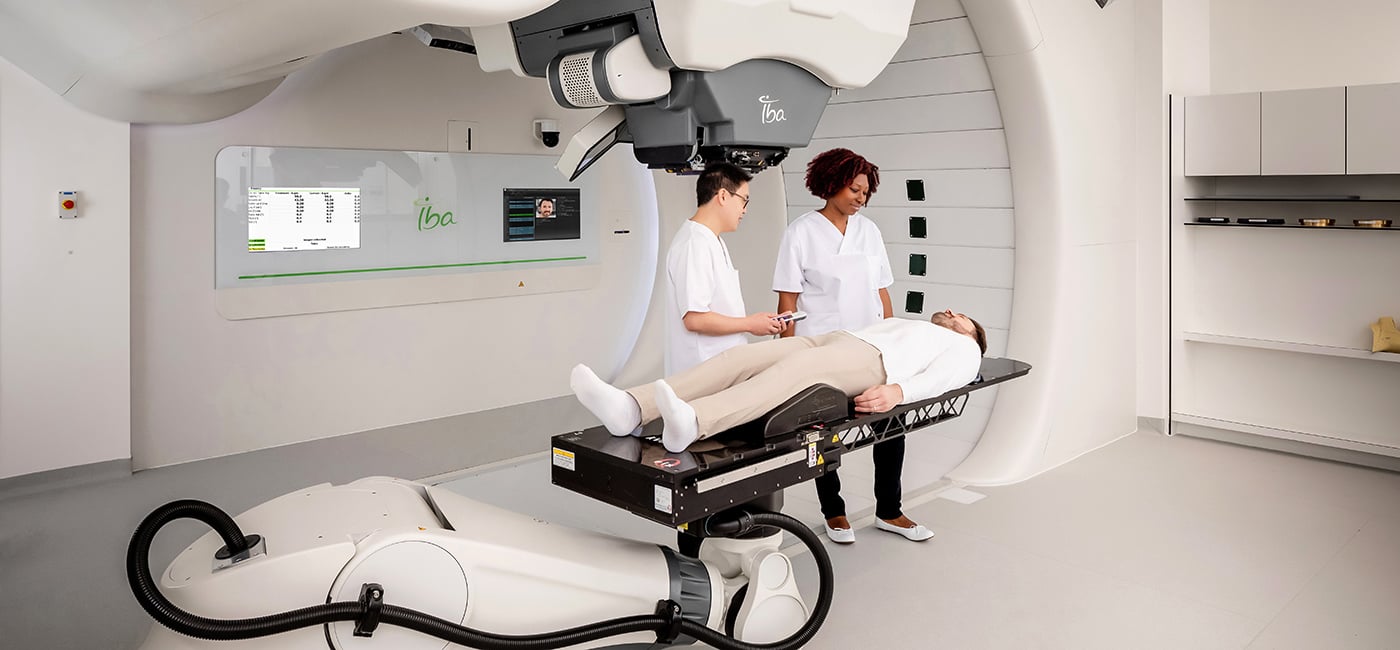
FAQ: Revolutionizing Radiation Treatment with Proton Therapy
Proton therapy is a novel modality to treat cancer patients as an alternative to standard radiation treatment. Proton therapy has shown tremendous improvements in a patient’s quality of life as it minimizes damage to healthy tissue surrounding a cancerous lesion, impacting only the targeted area. Moffitt Cancer Center is excited to partner with IBA (Ion Beam Applications S.A., EURONEXT), the world leader in particle accelerator technology, to bring proton therapy to our patients.
Moffitt is adding IBA’s Proteus®ONE compact proton therapy system as part of our ongoing expansion and aim of providing patients with the best outcomes. The proton therapy system will be installed at SPEROS FL, Moffitt’s 775-acre Global Innovation Center located in Pasco County.
What is proton therapy?
Proton therapy is an advanced form of radiation therapy. While conventional radiation uses photons, proton therapy uses protons—positively charged atomic particles (the nuclei of hydrogen atoms). Protons can be precisely controlled to release much of their energy directly into the tumor, thereby reducing damage to nearby healthy tissue.
How will the Speros proton therapy work?
Protons are energized in a charged atomic particle accelerator called a cyclotron and then manipulated to release their energy at precise depths within the patient being treated. The peak of the proton dose (called the Bragg Peak) is set so it releases the radiation when it hits the tumor; immediately after that point, the dose falls to almost zero. Less radiation reaches the healthy tissue in front of the tumor, and almost none reaches the healthy tissue beyond the tumor. This allows for increasing doses in some cases, and beam alignments that are not possible using conventional photons.
The Speros Proton Therapy Building will be adjacent to the Moffitt Speros Ambulatory Care Clinic and all internal radiation oncology spaces will be available within both buildings.
How do proton beams destroy cancer cells?
Protons deliver energy to cancer cells that damage their DNA. The damaged cells then die because they can no longer divide.

What are some of the common tumor sites treated with proton therapy?
Certain types of cancer are more appropriate for proton therapy than others. At Speros, we plan to offer proton therapy for the following:
- Abnormal/pelvic tumors
- Base-of-skull tumors
- Brain tumors
- Breast cancer
- Gastrointestinal tumors, including anal, rectal, pancreatic, esophageal and colon
- Head and neck tumors
- Lung cancer
- Pediatric cancers
- Pituitary gland tumors
- Prostate cancer
- Soft tissue tumors/sarcomas
- Tumors requiring re-irradiation
Can proton therapy be used to treat recurrent cancers?
In most cases, yes. At Speros, such cases will be discussed at a multidisciplinary tumor board prior to referral.
How is this therapy administrated?
Proton therapy is delivered like conventional (photon) radiation therapy. The patient is lined up on a treatment couch and images are taken to ensure proper alignment. The radiation therapists leave the room during the time the proton beam is on. Treatment times are generally less than three to five minutes.
What should a patient expect while the therapy is being delivered and the side effect following treatment?
Patients do not feel anything during proton therapy. Subsequent side effects vary depending on what part of the body is being treated and are discussed in depth with the patient prior to the treatment.
Can children receive proton therapy?
Proton therapy is especially indicated for children who need radiation therapy. Less normal tissue is irradiated with protons so children will have a lower chance of developmental problems and secondary tumors.
What is the plan for treating pediatric patients with protons at Speros?
Our current plan is to gradually integrate the ability to treat pediatric patients who do not require anesthesia in close collaboration with the our Regional Children’s Hospital team. We are currently gathering information on the required operational resources such as equipment, training, competencies and other regulatory requirements.
Is proton therapy new?
No. The first patient treated with protons was over 60 years ago. The U.S. Food and Drug Administration approved proton therapy as a radiation treatment option in 1988.
What is proton FLASH?
There’s been recent innovation in radiotherapy delivery using ultra-high dose rates that has a significant normal tissue-sparing effect called FLASH. For FLASH radiotherapy (FLASH RT) the treatment system has the ability to accelerate protons and deliver an entire treatment in two seconds or less. At these ultra-high dose rates, radiation biology appears to be quite different, that is, significantly less damage to normal tissues and may elicit a better immune response to the tumor.
However, with current technology FLASH is not yet FDA approved, is only practical with electron or proton beams, and would be only available in clinical trials when the SPEROS Proton center opens. Our Radiation Oncology Department is already conducting funded preclinical studies with electron FLASH as we get ready for clinical trials in patients in 2026.
If you’d like to refer a patient to Moffitt, complete our online form or contact a physician liaison for assistance. As part of our efforts to shorten referral times as much as possible, online referrals are typically responded to within 24 - 48 hours.
